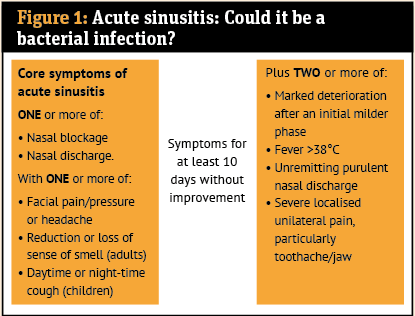Key information from history
Age: The Pharmacy First service includes adults and children aged 12 years and over. Pregnant females aged under 16 years should be referred.
Duration: Most cases of sinusitis are improving by day 10 and resolve in two to three weeks. Chronic sinusitis is defined as symptoms lasting for more than 12 weeks. Symptoms for around 10 days or fewer are more likely to be associated with a preceding cold rather than viral or bacterial acute sinusitis.
Associated symptoms:
- The affected sinus often feels tender when pressure is applied. It is typically worse on bending forwards or lying down
- The pain may be felt behind and around the eye, or over the cheek, with radiation over the forehead and often only one side is affected
- The headache may be associated with runny nose or nasal congestion
- Fever (above 38°C) is usually an indication of bacterial infection.
Previous history: Ask whether there has been a marked deterioration in sinusitis symptoms following a recent cold that had started to settle (so called ‘double sickening’) as this may be an indication of bacterial infection.
Patients may have had episodes of acute sinusitis previously. Recurrent episodes may relate to an incomplete response to antibiotics (sometimes due to resistance, or anatomical abnormalities affecting drainage, or nasal polyps). Patients who have had acute sinusitis before may expect to receive antibiotics if this has happened in the past.
Immunosuppressed patients, such as those on chemotherapy, should be referred (see PGDs for details). The features of a bacterial infection are summarised in Figure 1 below.

